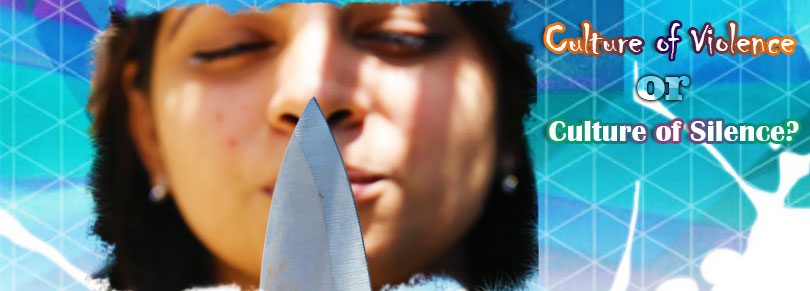Unresolved conflicts and ensuing violence have become a norm in our society. Whether it is at home, at the work place, among friends, relatives, neighbours, on the roads or in religious sanctuaries, we are left with a trail of bitterness, hurt, disappointment as well as injured or severed relationships. ‘When people lock horns in a courtroom, a congregational meeting, the bedroom, or the workplace, relationships are often severely damaged. Conflict robs us of immeasurable time, energy, money, and opportunities…’
Ken Sande Violence has become pervasive – from Los Angeles to Bagdad, Kabul to Karachi, and Colombo to New Delhi. In India, certain incidents are still fresh in our minds which leave us with a sense of fear like the death of a Delhi girl of 23 years, a paramedic student who was gang raped on a bus and the Maoists ambush that wiped out top leadership of the Congress party in Chhattisgarh. They are fresh perhaps because of extensive media coverage of these incidents.
Unfortunately, the debates on the news channels and print media have not discussed the deeper root causes of violence; rather they focus only on the cruelty of the perpetrators and lack of safety and security for the vulnerable.
But, what is violence?
Is it violence only when blood is shed or people hurt? Is it easy to identify violence and curb or punish it? Usually what we perceive as violence is direct visible violence where a person(s) kills / hurts the other. However this is not the only kind of violence. Much more prevalent are structural and cultural violence. Structural violence (difficult to trace the perpetrator) is lack of access to basic needs and services such as livelihood options, school in the neighbourhood or lack of transport to the nearest school and health care services; and cultural violence is anything that justifies or rationalises personal and structural violence, such as language, beliefs / norms, tradition etc.
Most of our reactions are towards the category of direct violence that is easily visible and directed to ‘other’ individuals and groups. However, we need to dig deeper. Violence against some begins at or before birth with the celebration of the boy child and foeticide or infanticide of the girl child. It continues through childhood through lack of access to nutrition, health, education, forced child labour, child abuse and more based on gender, caste, geography etc.
It is established as a norm and culture even through adulthood and in death through gender roles, caste system and more. The culture of gender and other inequalities is also promoted through subtle forms of socialisation including popular media that portray these oppressive values.
Culture of violence and culture of silence
Most of these stories of violence go unnoticed and unheard. On one hand, the dramatic rise of malls, multiplexes, apartment complexes on forcefully acquired land, and call centres operate on the logic of violence that remains unquestioned in the middle class narrative. On the other hand, the large scale disenfranchisement of the lower middle classes and the poor, embodied in massive displacement of the poor, further feeds into the culture of violence.
When the Adivasis and other indigenous people are evicted from their homes and lands and the land handed over to multi-national companies in the name of development we hardly perceive it as violence. But when some such groups rise up in arms then we cry out about violence. Often the intrinsic violence in the system and culture is like the huge iceberg that is concealed under water and the direct visible violence is like the tip seen above water.
The concealed ice is much stronger and the tip is only gives us a warning that we better watch out! The culture of violence is aided by the culture of silence. When we see child labour or human trafficking we avert our eyes and ignore their plight. When Special Economic Zones (SEZs) are set up at the cost of whole villages we laud the government’s efforts. Only when it strikes home we react.
For example, when my house will have to go to give way for the highway we petition the government to by-pass the city or town and oppose it. It is the culture of silence and selfishness that aids and establishes structural violence.
Heralding the culture of justice and peace
Gender violence and discrimination is one of the symptoms of a social order driven by conflict, injustice and insecurity. While we demand justice and demonstrate our anguish, we must not lose sight of the broader, long-term goal: to create conditions where women and men can work together towards a just and equitable social order.
Preventive measures against violence are as important as punitive ones. Both at home and workplaces, we need to respect fellow human beings instead of exercising power over them. When there is power imbalance in the family, school, community that tilts in favour of the male, the rich, the upper caste, it promotes the same in children who carry forward to the future, the inequality and injustice. Prevention of violence must begin by identifying and addressing the underlying causes of violence rather than its symptoms.
Conflict transformation involves change in attitude, culture, community life, and it’s structures that sustain and ‘normalise’ violence and exploitation. One of the biggest indicators of the culture of violence and culture of peace could be evidenced in the way we as members of society treat our children, maids, the disabled, other castes or socio-economic population; how we respond to situations of Adivasi communities that are caught in the crossfire between the Maoist and the State forces; how we respond to the trafficking of children and women for sex market and for bonded labour.
Being violent does not necessarily mean ones direct involvement in violence but also that of being silent about injustices around us. If the silent majority ceases to be silent about the atrocities and injustices, then the minority who directly perpetuate violence would be easily controlled and corrected.
The way forward
Above all, we must come to understand that violence is unacceptable. We must learn again the lesson of Pope Paul VI, “If you want peace, work for justice.” We oppose lawlessness of every kind. Society cannot tolerate an ethic which uses violence to make a point, settle grievances or get what we want. But the path to a more peaceful future is found in a rediscovery of personal responsibility, respect for human life and human dignity, and a recommitment to social justice.
The best antidote to violence is hope. People with a stake in society do not destroy communities. Both individuals and institutions should be held accountable for how they attack or enhance the common good. It is not only the “down and out” who must be held accountable, but also the “rich and famous.”
At the personal level, parents and teachers need to model to their children the culture of justice and peace.
- When children see their parents and teachers respect and treat everyone equally irrespective of gender, education, socio-economic status or appearances they too learn.
- When they see that we put other’s needs above ours and stand for what is right they too learn the value of Justice.
- When they see that in the midst ofroad rage and breaking traffics rules we hold our peace and do what is right they learn the culture of peace.
- When they observe how we treat our spouses with respect, share tasks beyond gender stereo types and resolve conflicts with open communication and mutual respect they carry the same baton forward.
In the name of culture and tradition, a lot of biases and stereotypes are packaged into our popular media. It is essential parents and teachers facilitate children to discuss topics such as dowry, sexual abuse, domestic violence, male-female roles at appropriate ages in a safe environment. As parents and teachers, we do have a great opportunity and responsibility. The change begins with me… Am I willing to pay the price or am I too comfortable in the culture of silence and satisfied with an occasional bickering about the State’s inefficiency? Will I be the harbinger of the culture of peace and justice? Be the change…begin today!
Contributed by Chitra & Rabbi Jayakaran. They are social workers heading Peacemakers, an NGO engaged in finding radical solutions for conflict and violence and sustaining justice and peace. They are also family life educators and counsellors.






